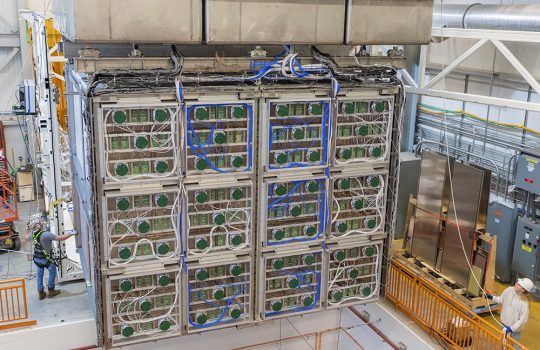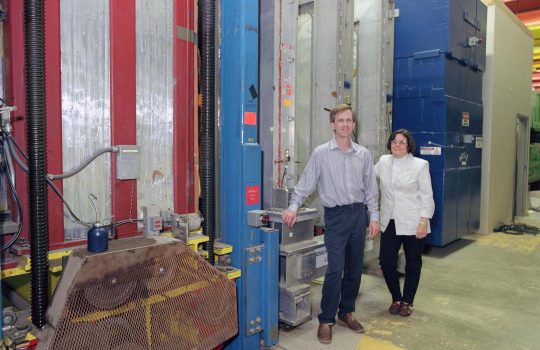For more than a decade, the particle physics community has faced a perplexing puzzle: two experiments, LSND at Los Alamos and MiniBooNE at Fermilab, found hints of neutrino behavior that did not fit the usual assumption that the universe contains three types of neutrinos that have tiny masses and oscillate.
The data from these two experiments suggest that something unusual is going on when low-energy muon neutrinos travel a short distance, less than a kilometer. The answer might be that there are additional types of neutrinos, albeit with properties different from the three “normal” types. These extras are known as sterile neutrinos. A confirmed discovery of a sterile neutrino would open up a whole new world of particles previously hidden from view.
Thanks to new results published by the MiniBooNE collaboration and presented at the Neutrino 2018 conference in Heidelberg this week, this neutrino mystery persists. The new data shows that the MiniBooNE signal has grown even stronger. Significantly stronger. The result suggests that there is almost no chance for the anomalous signal to be explained as merely a statistical fluctuation. (Read the press release from Los Alamos National Laboratory.)
That is exciting and very good news for the MicroBooNE experiment currently operating at Fermilab, as well as the ambitious Short-Baseline Neutrino Program that we are building here at Fermilab, together with our international partners at CERN and institutions in Italy, United Kingdom, Switzerland, Brazil and the United States (funded by the Department of Energy and National Science Foundation). Thanks to the work, vision and determination of neutrino physicists from around the world, we are now in a superb position to solve this neutrino mystery once and for all.
How did we get to this wonderful situation? The SBN Program combines the strengths of several proposals made a number of years ago. Scientists proposed to build a comprehensive set of neutrino detectors in Fermilab’s Booster neutrino beam, which also provided the neutrinos for MiniBooNE. The detectors would measure with great precision neutrino interactions at three locations along the beam, making the best possible measurement for short-baseline neutrino oscillation.
The SBN Program is based on three detectors that all have better particle identification than MiniBooNE thanks to the use of liquid-argon time projection chambers, which is also the technology that will be used for the international Deep Underground Neutrino Experiment hosted by Fermilab. And instead of sampling neutrino oscillations at just one location, as LSND and MiniBooNE did, respectively, the SBN Program will spread the three detectors along a straight line of about 500 meters so that together they can measure how neutrino oscillations unfold along that distance.
The next years will be exciting. The first of the three detectors, named MicroBooNE, is already taking data, and scientists just shared its first results at Neutrino 2018. The ICARUS detector, which was shipped from the Italian National Institute for Nuclear Physics’s Gran Sasso laboratory to CERN in Switzerland for refurbishment and then to Fermilab, will be the next to go online. It should start taking data in about a year. The third detector is known as the Short Baseline Near Detector, or SBND. It will be the closest to the origin of the Booster neutrino beam, at a distance of about 100 meters. Construction of SBND components is coming along well, and the entire detector should be operational in 2020.
Together, these detectors combine to form a powerful experiment to search for sterile neutrinos. The discovery of these particles would change the course of particle physics. Stay tuned.
Joe Lykken is the Fermilab chief research officer.




